Schema DSPL
Mantieni tutto organizzato con le raccolte
Salva e classifica i contenuti in base alle tue preferenze.
Questa pagina e le relative pagine secondarie documentano lo schema XML DSPL.
Questo materiale è rivolto a utenti avanzati che vogliono conoscere
dettagli di basso livello della lingua; per la maggior parte degli utenti, i contenuti
nel
Guida per gli sviluppatori dovrebbe essere sufficiente per la creazione e la modifica.
DSPL.
Lo schema XML completo è disponibile per il download in formato XSD
il
Sito del codice DSPL.
Elemento: dspl
| Spazio dei nomi |
http://schemas.google.com/dspl/2010 |
| Annotazioni |
Una specifica DSPL descrive un set di dati. Un set di dati è
identificato dal relativo spazio dei nomi. Un set di dati è composto da:
di elementi: - Tabelle: dati per i concetti e le sezioni definiti nella
- Concetti: le definizioni e le strutture specificate dall'utente utilizzate
Sezioni: combinazioni di dimensioni e metriche presenti nel
set di dati - Topics: Etichette gerarchiche utilizzate per organizzare i concetti
il set di dati |
| Diagramma |
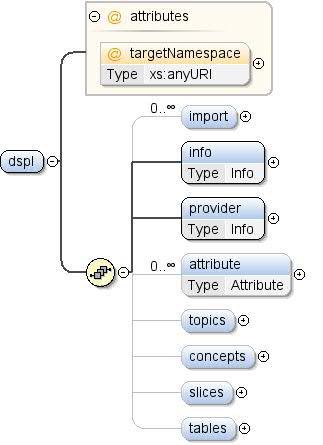 |
| Proprietà |
|
| Modello |
importazione* , informazioni , fornitore ,
attributo* , topics{0,1} , concetti{0,1} , sezioni{0,1} , tabelle{0,1} |
| Bambini |
attributo, concetti, importazione,
informazioni, fornitore, sezioni,
tabelle, argomenti |
| Istanza |
<dspl targetNamespace="">
<import location="" namespace="">{0,unbounded}</import>
<info>{1,1}</info>
<provider>{1,1}</provider>
<attribute concept="" id="">{0,unbounded}</attribute>
<topics>{0,1}</topics>
<concepts>{0,1}</concepts>
<slices>{0,1}</slices>
<tables>{0,1}</tables>
</dspl>
|
| Attributi |
| QName |
Tipo |
Risolto |
Predefinito |
Usa |
Annotazione |
| targetNamespace |
xs:anyURI |
|
|
facoltativo |
Ogni set di dati può fornire uno spazio dei nomi di destinazione. Il target
è un URI che identifica in modo univoco il set di dati. Per ulteriori informazioni
informazioni sull'utilizzo degli spazi dei nomi in XML, consulta:
http://www.w3.org/TR/REC-xml-names/ Se non è specificato alcuno spazio dei nomi target
viene generato uno spazio dei nomi quando il set di dati
importati. |
|
| Origine |
<xs:element name="dspl">
<xs:annotation>
<xs:documentation>A DSPL specification describes a dataset. A dataset is
identified by its namespace. A dataset is comprised of the
following elements:
- Tables: Data for the concepts and slices defined in the
dataset
- Concepts: User-specified definitions and structures used in
the dataset
- Slices: Combinations of dimensions and metrics present in
the dataset
- Topics: Hierarchical labels used to organise the concepts of
the dataset</xs:documentation>
</xs:annotation>
<xs:complexType>
<xs:sequence>
<xs:element name="import" minOccurs="0" maxOccurs="unbounded">
<xs:annotation>
<xs:documentation>Import directive for external datasets -- modeled after
the XML Schema import directive. In order to use
elements defined in an external dataset, the external
dataset must be referenced using an import directive.</xs:documentation>
</xs:annotation>
<xs:complexType>
<xs:attribute name="namespace" use="required">
<xs:annotation>
<xs:documentation>The namespace of the imported dataset, specified as
a URI. A prefix must be associated with this
namespace before its contents can be referenced. See
[XML Namespaces] for more information about the use
of namespaces and prefixes in XML.</xs:documentation>
</xs:annotation>
</xs:attribute>
<xs:attribute name="location" use="optional">
<xs:annotation>
<xs:documentation>An optional location where the definition of the
imported dataset can be found, specified as a
URL. If the location is omitted, the system
processing this DSPL dataset must already know the
imported dataset.
Implementation note: The Google dataset importer
ignores the location attribute. Any imported dataset
must be known by the Google importer beforehand.</xs:documentation>
</xs:annotation>
</xs:attribute>
</xs:complexType>
</xs:element>
<xs:element name="info" type="Info" minOccurs="1">
<xs:annotation>
<xs:documentation>General information about the dataset.</xs:documentation>
</xs:annotation>
</xs:element>
<xs:element name="provider" type="Info">
<xs:annotation>
<xs:documentation>General information about the dataset provider.</xs:documentation>
</xs:annotation>
</xs:element>
<xs:element name="attribute" type="Attribute" minOccurs="0" maxOccurs="unbounded">
<xs:annotation>
<xs:documentation>Attribute associated with the dataset.</xs:documentation>
</xs:annotation>
</xs:element>
<xs:element name="topics" minOccurs="0">
<xs:annotation>
<xs:documentation>A hierarchy of topics used to organize the contents of
the dataset. The order in which topics are given is
meaningful and should be respected by visualizations
that displays these topics.</xs:documentation>
</xs:annotation>
<xs:complexType>
<xs:sequence>
<xs:element name="topic" type="Topic" maxOccurs="unbounded"/>
</xs:sequence>
</xs:complexType>
</xs:element>
<xs:element name="concepts" minOccurs="0">
<xs:annotation>
<xs:documentation>A list of concepts defined in this dataset.</xs:documentation>
</xs:annotation>
<xs:complexType>
<xs:sequence>
<xs:element name="concept" type="Concept" maxOccurs="unbounded"/>
</xs:sequence>
</xs:complexType>
</xs:element>
<xs:element name="slices" minOccurs="0">
<xs:annotation>
<xs:documentation>A list of slices defined in this dataset.</xs:documentation>
</xs:annotation>
<xs:complexType>
<xs:sequence>
<xs:element name="slice" type="Slice" maxOccurs="unbounded"/>
</xs:sequence>
</xs:complexType>
</xs:element>
<xs:element name="tables" minOccurs="0">
<xs:annotation>
<xs:documentation>A list of tables defined in this dataset.</xs:documentation>
</xs:annotation>
<xs:complexType>
<xs:sequence>
<xs:element name="table" type="Table" maxOccurs="unbounded"/>
</xs:sequence>
</xs:complexType>
</xs:element>
</xs:sequence>
<xs:attribute name="targetNamespace" type="xs:anyURI" use="optional">
<xs:annotation>
<xs:documentation>Each dataset may provide a target namespace. The
target namespace is a URI that uniquely identifies the
dataset. For more information about the use of namespaces in XML,
see:
http://www.w3.org/TR/REC-xml-names/
If no targetNamespace is provided, then a namespace will be
generated when the dataset is imported.</xs:documentation>
</xs:annotation>
</xs:attribute>
</xs:complexType>
</xs:element>
|
Elemento: dspl / import
| Spazio dei nomi |
http://schemas.google.com/dspl/2010 |
| Annotazioni |
Direttiva di importazione per i set di dati esterni sulla base del file XML
Istruzione di importazione dello schema. Per utilizzare elementi definiti in un modello
è necessario fare riferimento al set di dati esterno utilizzando una
. |
| Diagramma |
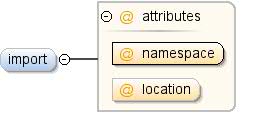 |
| Proprietà |
| contenuti: |
complesso |
| minOccurs: |
0 |
| maxOccurs: |
illimitati |
|
| Attributi |
| QName |
Tipo |
Risolto |
Predefinito |
Usa |
Annotazione |
| località |
|
|
|
facoltativo |
Una posizione facoltativa in cui la definizione del file
il set di dati specificato come URL. Se la località è
omesso, il sistema che elabora questo set di dati DSPL deve già conoscere
il set di dati importato. Nota di implementazione: set di dati di Google
l'importer ignora l'attributo località. Qualsiasi set di dati importato deve
essere prima noti all'importatore Google. |
| spazio dei nomi |
|
|
|
di provisioning. |
Lo spazio dei nomi del set di dati importato, specificato come
URI. Un prefisso deve essere associato a questo spazio dei nomi prima del suo
fare riferimento ai contenuti. Per saperne di più, consulta [spazi dei nomi XML]
informazioni sull'uso di spazi dei nomi e prefissi in
XML. |
|
| Origine |
<xs:element name="import" minOccurs="0" maxOccurs="unbounded">
<xs:annotation>
<xs:documentation>Import directive for external datasets -- modeled after
the XML Schema import directive. In order to use
elements defined in an external dataset, the external
dataset must be referenced using an import directive.</xs:documentation>
</xs:annotation>
<xs:complexType>
<xs:attribute name="namespace" use="required">
<xs:annotation>
<xs:documentation>The namespace of the imported dataset, specified as
a URI. A prefix must be associated with this
namespace before its contents can be referenced. See
[XML Namespaces] for more information about the use
of namespaces and prefixes in XML.</xs:documentation>
</xs:annotation>
</xs:attribute>
<xs:attribute name="location" use="optional">
<xs:annotation>
<xs:documentation>An optional location where the definition of the
imported dataset can be found, specified as a
URL. If the location is omitted, the system
processing this DSPL dataset must already know the
imported dataset.
Implementation note: The Google dataset importer
ignores the location attribute. Any imported dataset
must be known by the Google importer beforehand.</xs:documentation>
</xs:annotation>
</xs:attribute>
</xs:complexType>
</xs:element>
|
Elemento: dspl / info
| Spazio dei nomi |
http://schemas.google.com/dspl/2010 |
| Annotazioni |
Informazioni generali sul set di dati. |
| Diagramma |
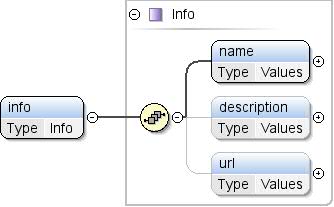 |
| Tipo |
Informazioni |
| Proprietà |
| contenuti: |
complesso |
| minOccurs: |
1 |
|
| Modello |
name , description{0,1} , url{0,1} |
| Bambini |
descrizione, nome, url |
| Istanza |
<info>
<name>{1,1}</name>
<description>{0,1}</description>
<url>{0,1}</url>
</info>
|
| Origine |
<xs:element name="info" type="Info" minOccurs="1">
<xs:annotation>
<xs:documentation>General information about the dataset.</xs:documentation>
</xs:annotation>
</xs:element>
|
Elemento: dspl / provider
| Spazio dei nomi |
http://schemas.google.com/dspl/2010 |
| Annotazioni |
Informazioni generali sul fornitore del set di dati. |
| Diagramma |
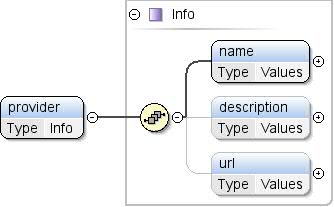 |
| Tipo |
Informazioni |
| Proprietà |
|
| Modello |
name , description{0,1} , url{0,1} |
| Bambini |
descrizione, nome, url |
| Istanza |
<provider>
<name>{1,1}</name>
<description>{0,1}</description>
<url>{0,1}</url>
</provider>
|
| Origine |
<xs:element name="provider" type="Info">
<xs:annotation>
<xs:documentation>General information about the dataset provider.</xs:documentation>
</xs:annotation>
</xs:element>
|
Elemento: dspl / attributo
| Spazio dei nomi |
http://schemas.google.com/dspl/2010 |
| Annotazioni |
Attributo associato al set di dati. |
| Diagramma |
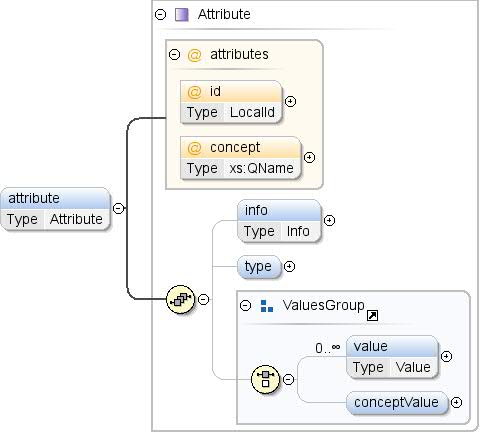 |
| Tipo |
Attributo |
| Proprietà |
| contenuti: |
complesso |
| minOccurs: |
0 |
| maxOccurs: |
illimitati |
|
| Modello |
info{0,1} , tipo{0,1} , (valore*
| conceptValue{0,1}) |
| Bambini |
conceptValue, informazioni, tipo,
valore |
| Istanza |
<attribute concept="" id="">
<info>{0,1}</info>
<type format="" ref="">{0,1}</type>
</attribute>
|
| Attributi |
| QName |
Tipo |
Risolto |
Predefinito |
Usa |
Annotazione |
| concetto |
xs:QName |
|
|
facoltativo |
Un riferimento a un concetto che corrisponde ai valori
dell'attributo. Se l'attributo specifica un tipo, allora il tipo
deve corrispondere al tipo del concetto a cui viene fatto riferimento. Un riferimento a un
il concetto esterno deve avere il formato
"prefix:other_concept_id", dove "prefisso" sono
il prefisso utilizzato per lo spazio dei nomi del set di dati esterno (vedi XML
spazi dei nomi). |
| id |
LocalId |
|
|
facoltativo |
L'ID dell'attributo del concetto. Questo identificatore deve essere
univoci all'interno del concetto (tra attributi e proprietà). La
L'attributo id [id] può essere omesso se viene specificato l'attributo concettuale. In questo
case, un ID viene creato implicitamente con il valore il nome locale del
concetto a cui viene fatto riferimento. Ad esempio <attribute
concept="unit:currency"/> equivale a
<attribute id="currency"
concept="unit:currency"/> |
|
| Origine |
<xs:element name="attribute" type="Attribute" minOccurs="0" maxOccurs="unbounded">
<xs:annotation>
<xs:documentation>Attribute associated with the dataset.</xs:documentation>
</xs:annotation>
</xs:element>
|
Elemento: dspl / argomenti
| Spazio dei nomi |
http://schemas.google.com/dspl/2010 |
| Annotazioni |
Una gerarchia di argomenti utilizzati per organizzare i contenuti
del set di dati. L'ordine in cui vengono forniti gli argomenti è significativo e dovrebbe essere
rispettata dalle visualizzazioni che mostrano questi argomenti. |
| Diagramma |
 |
| Proprietà |
| contenuti: |
complesso |
| minOccurs: |
0 |
|
| Modello |
argomento+ |
| Bambini |
argomento |
| Istanza |
<topics>
<topic id="" parentTopic="">{1,unbounded}</topic>
</topics>
|
| Origine |
<xs:element name="topics" minOccurs="0">
<xs:annotation>
<xs:documentation>A hierarchy of topics used to organize the contents of
the dataset. The order in which topics are given is
meaningful and should be respected by visualizations
that displays these topics.</xs:documentation>
</xs:annotation>
<xs:complexType>
<xs:sequence>
<xs:element name="topic" type="Topic" maxOccurs="unbounded"/>
</xs:sequence>
</xs:complexType>
</xs:element>
|
| Spazio dei nomi |
http://schemas.google.com/dspl/2010 |
| Diagramma |
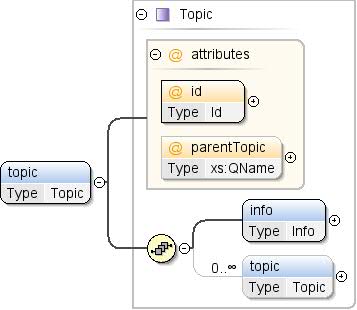 |
| Tipo |
Argomento |
| Proprietà |
| contenuti: |
complesso |
| maxOccurs: |
illimitati |
|
| Modello |
informazioni , argomento* |
| Bambini |
informazioni, argomento |
| Istanza |
<topic id="" parentTopic="">
<info>{1,1}</info>
<topic id="" parentTopic="">{0,unbounded}</topic>
</topic>
|
| Attributi |
| QName |
Tipo |
Risolto |
Predefinito |
Usa |
Annotazione |
| id |
ID |
|
|
di provisioning. |
L'identificatore univoco dell'argomento nella sezione
del set di dati. |
| parentTopic |
xs:QName |
|
|
facoltativo |
L'ID dell'argomento principale di questo argomento, se presente.
Impossibile specificare parentTopic per gli argomenti incorporati
su altri argomenti. |
|
| Origine |
<xs:element name="topic" type="Topic" maxOccurs="unbounded"/>
|
Elemento: dspl / concetti
| Spazio dei nomi |
http://schemas.google.com/dspl/2010 |
| Annotazioni |
Un elenco di concetti definiti in questo set di dati. |
| Diagramma |
 |
| Proprietà |
| contenuti: |
complesso |
| minOccurs: |
0 |
|
| Modello |
concetto+ |
| Bambini |
concetto |
| Istanza |
<concepts>
<concept extends="" id="">{1,unbounded}</concept>
</concepts>
|
| Origine |
<xs:element name="concepts" minOccurs="0">
<xs:annotation>
<xs:documentation>A list of concepts defined in this dataset.</xs:documentation>
</xs:annotation>
<xs:complexType>
<xs:sequence>
<xs:element name="concept" type="Concept" maxOccurs="unbounded"/>
</xs:sequence>
</xs:complexType>
</xs:element>
|
| Spazio dei nomi |
http://schemas.google.com/dspl/2010 |
| Diagramma |
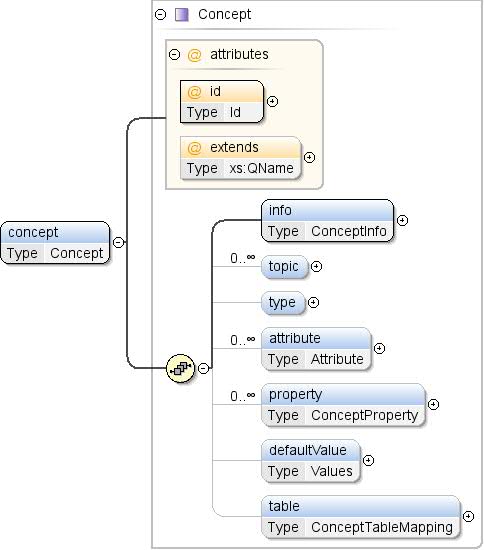 |
| Tipo |
Concetto |
| Proprietà |
| contenuti: |
complesso |
| maxOccurs: |
illimitati |
|
| Modello |
informazioni , argomento* , tipo{0,1} ,
attributo* , property* , defaultValue{0,1} , tabella{0,1} |
| Bambini |
attribute, defaultValue, info,
proprietà, tabella, argomento,
tipo |
| Istanza |
<concept extends="" id="">
<info>{1,1}</info>
<topic ref="">{0,unbounded}</topic>
<type ref="">{0,1}</type>
<attribute concept="" id="">{0,unbounded}</attribute>
<property concept="" id="" isMapping="false" isParent="false">{0,unbounded}</property>
<defaultValue>{0,1}</defaultValue>
<table ref="">{0,1}</table>
</concept>
|
| Attributi |
| QName |
Tipo |
Risolto |
Predefinito |
Usa |
Annotazione |
| estende |
xs:QName |
|
|
facoltativo |
L'identificatore univoco di un concetto a cui
si estende. Il concetto a cui viene fatto riferimento può essere definito nello stesso set di dati
o esternamente, ad esempio in un altro set di dati. Un riferimento a una risorsa
deve essere nel formato "prefix:other_concept_id",
dove "prefisso" è il prefisso utilizzato per lo spazio dei nomi
il set di dati esterno (vedi gli spazi dei nomi XML). |
| id |
ID |
|
|
di provisioning. |
L'identificatore univoco del concetto, che deve essere
globalmente univoci all'interno del set di dati. |
|
| Origine |
<xs:element name="concept" type="Concept" maxOccurs="unbounded"/>
|
Elemento: dspl / sezioni
| Spazio dei nomi |
http://schemas.google.com/dspl/2010 |
| Annotazioni |
Un elenco di sezioni definite in questo set di dati. |
| Diagramma |
 |
| Proprietà |
| contenuti: |
complesso |
| minOccurs: |
0 |
|
| Modello |
fetta+ |
| Bambini |
fetta |
| Istanza |
<slices>
<slice id="">{1,unbounded}</slice>
</slices>
|
| Origine |
<xs:element name="slices" minOccurs="0">
<xs:annotation>
<xs:documentation>A list of slices defined in this dataset.</xs:documentation>
</xs:annotation>
<xs:complexType>
<xs:sequence>
<xs:element name="slice" type="Slice" maxOccurs="unbounded"/>
</xs:sequence>
</xs:complexType>
</xs:element>
|
Elemento: dspl / sezioni / sezione
| Spazio dei nomi |
http://schemas.google.com/dspl/2010 |
| Diagramma |
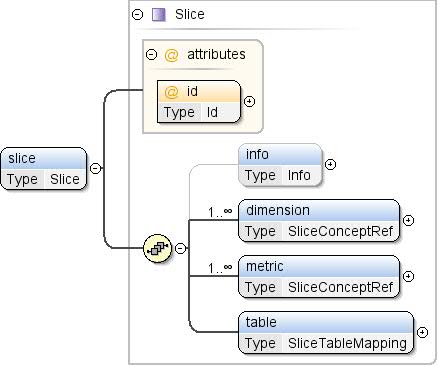 |
| Tipo |
Sezione |
| Proprietà |
| contenuti: |
complesso |
| maxOccurs: |
illimitati |
|
| Modello |
informazioni{0,1} , dimensione+ , metrica+
, tabella |
| Bambini |
dimensione, informazioni, metrica,
tabella |
| Istanza |
<slice id="">
<info>{0,1}</info>
<dimension concept="">{1,unbounded}</dimension>
<metric concept="">{1,unbounded}</metric>
<table ref="">{1,1}</table>
</slice>
|
| Attributi |
| QName |
Tipo |
Risolto |
Predefinito |
Usa |
Annotazione |
| id |
ID |
|
|
di provisioning. |
L'identificatore univoco della sezione. |
|
| Origine |
<xs:element name="slice" type="Slice" maxOccurs="unbounded"/>
|
Elemento: dspl / tabelle
| Spazio dei nomi |
http://schemas.google.com/dspl/2010 |
| Annotazioni |
Un elenco di tabelle definite in questo set di dati. |
| Diagramma |
 |
| Proprietà |
| contenuti: |
complesso |
| minOccurs: |
0 |
|
| Modello |
tabella+ |
| Bambini |
tabella |
| Istanza |
<tables>
<table id="">{1,unbounded}</table>
</tables>
|
| Origine |
<xs:element name="tables" minOccurs="0">
<xs:annotation>
<xs:documentation>A list of tables defined in this dataset.</xs:documentation>
</xs:annotation>
<xs:complexType>
<xs:sequence>
<xs:element name="table" type="Table" maxOccurs="unbounded"/>
</xs:sequence>
</xs:complexType>
</xs:element>
|
Elemento: dspl / tabelle / tabella
| Spazio dei nomi |
http://schemas.google.com/dspl/2010 |
| Diagramma |
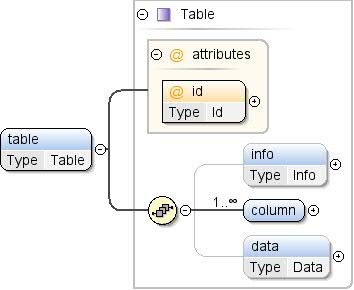 |
| Tipo |
Tabella |
| Proprietà |
| contenuti: |
complesso |
| maxOccurs: |
illimitati |
|
| Modello |
informazioni{0,1} , colonna+ , dati{0,1} |
| Bambini |
colonna, dati, informazioni |
| Istanza |
<table id="">
<info>{0,1}</info>
<column format="" id="" type="">{1,unbounded}</column>
<data>{0,1}</data>
</table>
|
| Attributi |
| QName |
Tipo |
Risolto |
Predefinito |
Usa |
Annotazione |
| id |
ID |
|
|
di provisioning. |
L'identificatore univoco della tabella nel
del set di dati. |
|
| Origine |
<xs:element name="table" type="Table" maxOccurs="unbounded"/>
|
Attributo: dspl / import / @namespace
| Spazio dei nomi |
Nessuno spazio dei nomi |
| Annotazioni |
Lo spazio dei nomi del set di dati importato, specificato come URI. R
il prefisso deve essere associato a questo spazio dei nomi prima di poterne eseguire il contenuto
a cui viene fatto riferimento. Consulta [spazi dei nomi XML] per ulteriori informazioni sull'uso di
e prefissi in XML. |
| Proprietà |
|
| Usato da |
|
| Origine |
<xs:attribute name="namespace" use="required">
<xs:annotation>
<xs:documentation>The namespace of the imported dataset, specified as
a URI. A prefix must be associated with this
namespace before its contents can be referenced. See
[XML Namespaces] for more information about the use
of namespaces and prefixes in XML.</xs:documentation>
</xs:annotation>
</xs:attribute>
|
Attributo: dspl / import / @location
| Spazio dei nomi |
Nessuno spazio dei nomi |
| Annotazioni |
Una posizione facoltativa in cui la definizione del file
il set di dati specificato come URL. Se la località viene omessa, il valore
che il sistema che elabora questo set di dati DSPL deve già conoscere
del set di dati. Nota sull'implementazione: lo strumento di importazione dei set di dati di Google ignora
località. Qualsiasi set di dati importato deve essere noto a Google
importatore in anticipo. |
| Proprietà |
|
| Usato da |
|
| Origine |
<xs:attribute name="location" use="optional">
<xs:annotation>
<xs:documentation>An optional location where the definition of the
imported dataset can be found, specified as a
URL. If the location is omitted, the system
processing this DSPL dataset must already know the
imported dataset.
Implementation note: The Google dataset importer
ignores the location attribute. Any imported dataset
must be known by the Google importer beforehand.</xs:documentation>
</xs:annotation>
</xs:attribute>
|
Attributo: dspl / @targetNamespace
| Spazio dei nomi |
Nessuno spazio dei nomi |
| Annotazioni |
Ogni set di dati può fornire uno spazio dei nomi di destinazione. Il target
è un URI che identifica in modo univoco il set di dati. Per ulteriori informazioni
informazioni sull'utilizzo degli spazi dei nomi in XML, consulta:
http://www.w3.org/TR/REC-xml-names/ Se non viene fornito uno spazio dei nomi target,
verrà generato uno spazio dei nomi quando il set di dati
importati. |
| Tipo |
xs:anyURI |
| Proprietà |
|
| Usato da |
|
| Origine |
<xs:attribute name="targetNamespace" type="xs:anyURI" use="optional">
<xs:annotation>
<xs:documentation>Each dataset may provide a target namespace. The
target namespace is a URI that uniquely identifies the
dataset. For more information about the use of namespaces in XML,
see:
http://www.w3.org/TR/REC-xml-names/
If no targetNamespace is provided, then a namespace will be
generated when the dataset is imported.</xs:documentation>
</xs:annotation>
</xs:attribute>
|
Creato con
Editor XML ossigeno.
Salvo quando diversamente specificato, i contenuti di questa pagina sono concessi in base alla licenza Creative Commons Attribution 4.0, mentre gli esempi di codice sono concessi in base alla licenza Apache 2.0. Per ulteriori dettagli, consulta le norme del sito di Google Developers. Java è un marchio registrato di Oracle e/o delle sue consociate.
Ultimo aggiornamento 2025-07-25 UTC.
[[["Facile da capire","easyToUnderstand","thumb-up"],["Il problema è stato risolto","solvedMyProblem","thumb-up"],["Altra","otherUp","thumb-up"]],[["Mancano le informazioni di cui ho bisogno","missingTheInformationINeed","thumb-down"],["Troppo complicato/troppi passaggi","tooComplicatedTooManySteps","thumb-down"],["Obsoleti","outOfDate","thumb-down"],["Problema di traduzione","translationIssue","thumb-down"],["Problema relativo a esempi/codice","samplesCodeIssue","thumb-down"],["Altra","otherDown","thumb-down"]],["Ultimo aggiornamento 2025-07-25 UTC."],[],["The DSPL XML schema defines a dataset's structure using key components: `tables`, `concepts`, `slices`, and `topics`. The root `dspl` element encapsulates the dataset, utilizing `import` to reference externals, `info` and `provider` for metadata, `attribute` for dataset attributes, and `topics` to hierarchically organize the concepts. `concepts`, `slices`, `tables` are for concept definition, slice definition, and data table, respectively. Each element like `import`, `info`, `provider`, `attribute`, `topic`, `concept`, `slice`, `table` uses specific attributes and child elements for configuration. Each element has a specific cardinality that is defined in the document.\n"]]













